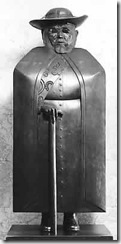Tuesday, April 15, 2008
Today in Hawaiian history: April 15, 1899, Father Damien dies
While visiting our congressional delegation last year we walked from the House office building to the Senate office building through the corridors of the Capitol, brushing up against tourists, congresspeople, high- and low-powered lobbyists and seemingly half the population of Washington DC. Everyone was there. The crowd resembled rush hour in the Ginza in Tokyo.
Along one corridor wall we were surprised to see this bronze statue of Father Damien, a work of sculptor Marison Escobar. Father Damien is currently a candidate for sainthood.
According to the WIkipedia, Father Damien (Joseph de Veuster) was a Roman Catholic priest from Belgium and member of the Congregation of the Sacred Hearts of Jesus and Mary, a missionary religious order.
Damien is known for love and ministering to people with what was then widely known as leprosy, forced by government-sanctioned medical segregation, living on the island of Molokai in the Kingdom of Hawaii. In the Roman Catholic and Anglican traditions, as well as other denominations of Christianity, Damien is considered the spiritual patron for Hansen's Disease, HIV and AIDS patients as well as outcasts. As the patron saint of the Roman Catholic Diocese of Honolulu and of Hawaii, Father Damien Day is celebrated statewide on April 15. Upon his beatification towards canonization and sainthood by Pope John Paul II in 1995, Damien was given a memorial feast day, celebrated on May 10 on the church calendar and was conferred the official title of Blessed Damien of Molokai.
In going to serve at the quarantined settlement of Kalaupapa on Molokai, Father Damien knew he would die there.
On May 10, 1873, Damien arrived at the secluded settlement at Kalaupapa. Bishop Maigret presented Damien to the colonists as "one who will be a father to you, and who loves you so much that he does not hesitate to become one of you; to live and die with you." The settlement was surrounded by an impregnable mountain ridge. There were 816 lepers living at Kalaupapa.
Conditions at Kalaupapa were disgraceful. Although the colony was supplied with food, there were no medical services.
Sociologists argued before the Roman Curia in proceedings for sainthood that Damien was sent to a morally deprived, lawless "colony of death" where people were forced to fight each other to survive. The kingdom didn't plan the settlement to be in such disarray but the government's neglect in providing much needed resources and medical help created the chaos. Damien's arrival is seen as a turning point for the community. Under his leadership, basic laws were enforced, shacks became painted houses, working farms were organized and schools were erected.
Father Damien died on April 15, 1889, of the disease.
(Many thanks to Scott Crawford over in Hana, Maui, and his Hawaiian Independence Blog, for starting a cultural and historical calendar, on which this is based.)



Post a Comment
Requiring those Captcha codes at least temporarily, in the hopes that it quells the flood of comment spam I've been receiving.